

|
|
 |
 |
 |

|
 |
BMW Garage | BMW Meets | Register | Today's Posts | Search |
 |

|
BMW 3-Series (E90 E92) Forum
>
Procede News: Independence Day (from off-the-shelf tunes!). New Procede User Software
|
 |
| 07-03-2011, 09:38 PM | #1 |

1737
Rep 17,960
Posts
Drives: A Lot
Join Date: Sep 2006
Location: SF Bay, CA
iTrader: (0)
Garage List 2018 Ducati Panigal ... [0.00]
2016 Mazda CX5 [0.00] 2017 Aprilia Tuono ... [0.00] 2019 BMW M2 Competi ... [0.00] 2015 BMW M5 Competi ... [10.00] 2016 Ducati XDiavel S [0.00] 2016 AMG GT S [0.00] 2011 Ferrari 458 It ... [0.00] 2017 Charger Hellcat [0.00] 2015 KTM Super Duke ... [0.00] 2016 KTM RC390 [0.00] |
Procede News: Independence Day (from off-the-shelf tunes!). New Procede User Software
Hi guys,
Happy 4th of July weekend to all! We've been quite on the forums and this should explain why. One of the things we've been working on for quite some time now is a brand new Procede User Software. But unlike earlier versions, one that gives the user full effective map-abiity. This software will allow any competent user to dial in their car for their particular modifications and conditions. While autotuning gave the ability to effectively scale between one conservative map and one aggressive map, it did not allow you to tune the two map ranges. And while wastegate compensation scaled the Wastegate DC table with respect to average PID error correction, it did not "shape" the map to best suite any given set-up. Nor could you set discrete values/settings such as PID components, integral delays, throttle reaction coefficients, warm-up thresholds, gear change sensitivities, overboost thresholds, slew rate limters, 3D AFR targets and so on and so on. While we got closer than any other kind of off-the-shelf map, we could not, by its very nature, be spot-on in all applications, in all conditions. That is going to change now. Of course, with fully functional User Programming Software comes full tuning documentation. We are going to start off with a Basic tutorial covering the more basic tables and then release an intermediate and advance tutorial covering the secondary, but equally important tables/settings/values. While not everyone will want to learn this, those who do can benefit greatly from following our step-by-step custom tuning suggestions. Those who do not feel comfortable doing this, can simply run the default maps. They will give up a bit of performance. But they are as good as it gets without stepping into the realm of custom tuning. Projected release date for the User Programming Software is Monday, July 11th. We are just finishing up some documentation/details at this time. Here is the preliminary version of the Basic Tutorial. It will develop over time as we get more feedback and enable more maps/settings for user adjustability. Currently, there are about 20 maps/tables/settings enabled for customer adjust-ability. As we document more and ensure that value ranges are limited for safety, we will enable more. Eventually, we should have over 200 available for customers. But 99.9% of customer needs should be satisfied with the User Programming Software at initial launch. It's also worth mentioning that we have added several new datalog channels. All of which are there to facilitate the custom tuning process. Here's a peek of what we have documented so far: Procede N54 User Tuning Software Basic Tutorial FUEL MAPPING Open Loop Fuel Map 1 (Open Loop Fuel table for Map1) 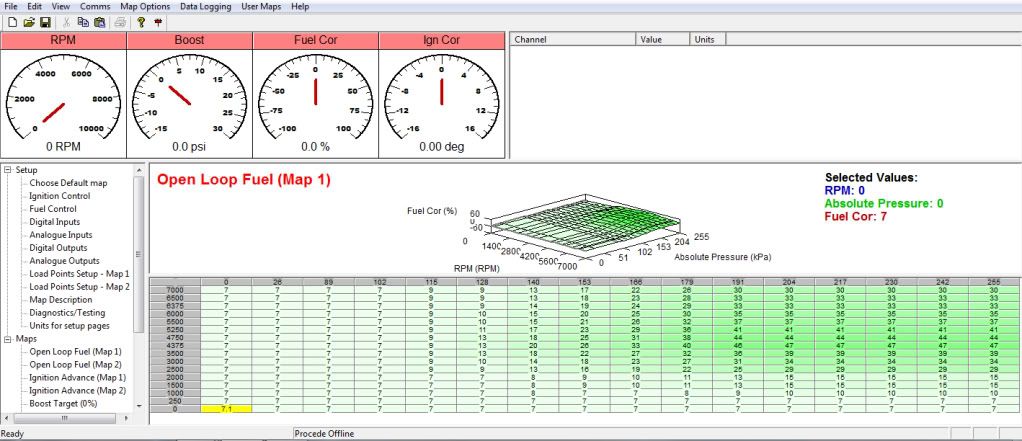 This map controls open loop fuel delivery. The larger the positive number, the more fuel delivery. It is important to keep transitions between cells relatively smooth or else you may induce drivability issues (hiccups, hesitations, etc.) as you transition from load to load or rpm to rpm. This table does not define the AFR target. This table defines the initial fuel output before the DME’s closed loop fuel control feature becomes active. This means that is useful to “dial in” this table so it works complementarily with the AFR Target table. You can do this by monitoring/datalogging Fuel Trims (debug word 5 and de increasing the values the appropriate rpm/load cells. Conversely, if you log very negative fuel trims, you can increase them by decreasing the values in the appropriate rpm/load cells. It is impossible to map the fuel table to always see WOT fuel trims of 0% as conditions are always changing. A good rule of thumb is to dial in this table so that fuel trims are in the +10 to +15% range. Targeting very negative fuel trims (-20 to -34%) would mean that the car would initially run rich for a moment before the CL (Closed Loop) fuel system added its corrective fuel trim. This sounds safe but can results in very obvious drivability issues (misfire, bogging, etc,.) during sudden changes of throttle position. Likewise, targeting very positive fuel trims (+20 to +34%) would mean that the engine would initially run lean until the CL fuel system added its corrective trim. The CL fuel system has a range of +34 to -34%). If you see logs showing sustained max or min values, the CL fuel system isn’t able to induce enough trim to achieve the desired AFR target. So if trims are +34%, this means the engine is running leaner than the target. If trims are -34, the engine is running richer than the target. In either case, open loop fueling should be adjusted. This can be done globally through the Open Loop Fueling User Adjustable. Or, with much higher granularity, through Open Loop Fuel table itself. If adjusting through the User Adjustable parameter, only a global scalar offset will be applied (ie, it will reduce/increase fuel delivery across the board by the same %). The Y-axis represents RPM. The X-axis is charge pipe pressure (pre-throttle body) in kiloPascals (kPA). 100kPa is equal to 1 bar (1 atmospheric pressure or 14.5psi) at sea level (0psi). 200kPa is equal to 2 bar of pressure (1 bar, or 14.5psi of boost) The active cell is highlighted when the User Software is connected to the Procede. Changes to this table can be made "on the fly" with the engine running. No Procede resetting necessary. Open Loop Fuel Map 2 (Open Loop Fuel table for Map2) Same as above but for Map2. For those running methanol injection, it’s useful to dial this table in properly to avoid seeing big fuel trim swings when methanol spray enables/disables. So the larger the nozzle you run (and/or the stronger the methanol mix), the lower the values should be in Fuel Map 2. If you do not adjust this table accordingly, running big nozzles can result in short-term (before CL fuel system can correct for it) rich conditions that can cause partial throttle hesitations or degrade engine response while transitioning from one throttle/load combination to another. If you dial in both Fuel Map1 and Fuel Map2 properly, you should be able to see any significant changes to fuel trims as methanol turns on/off. As with Fuel map 1, a simpler (but less precise) alternative to adjusting the values in this table is to adjust the Open Loop Fueling adjustable value. If you are not running progressive methanol injection, you can set Fuel Map 2 equal to Fuel Map 1. The Y-axis represents RPM. The X-axis is charge pipe pressure (pre-throttle body) in kiloPascals (kPA). 100kPa is equal to 1 bar (1 atmospheric pressure or 14.5psi) at sea level (0psi). 200kPa is equal to 2 bar of pressure (1 bar, or 14.5psi of boost) The active cell is highlighted when the User Software is connected to the Procede. Changes to this table can be made "on the fly" with the engine running. No Procede resetting necessary. AFR Target Offset (Air-Fuel Ratio Target Offset for both Map1 and Map2) 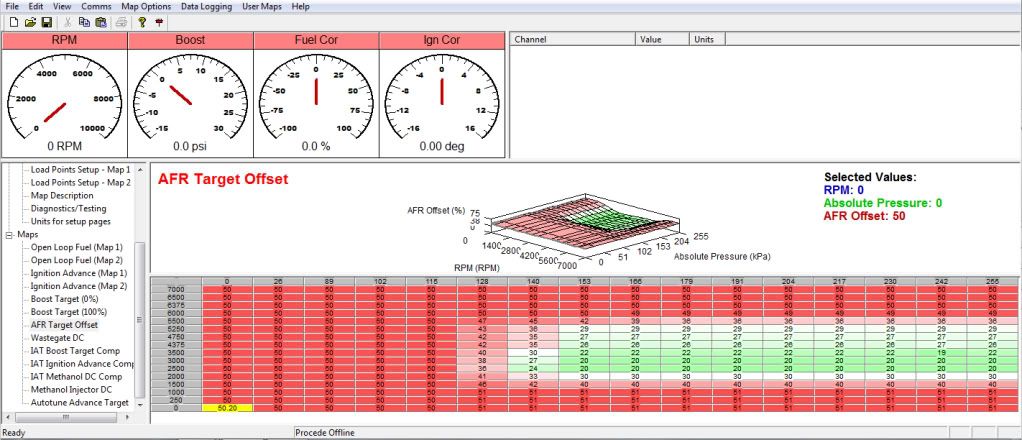 This map defines the Air/Fuel Ratio target correction applied by the Procede. This is accomplished by applying a bias voltage to the wideband o2 sensors. Rev2a and Rev2b hardware have slightly different bias circuitry which results in different adjustment ranges. The original Rev2a boards are able to adjust AFR +/-2 points. Whereas the newer Rev2b is able to adjust within a much wider +/- 3 point range. A map value of 50% results in no AFR correction (ie, the standard AFR value is targeted). Values higher than 50% will enlean the AFR target. Values lower than 50% will enrich the target. Inputting a value of 0% will lower the nominal AFR target by 2-3 points (depending on board revision). Inputting a value of 100% will increase the nominal AFR target by 2-3 points. Typically, you will find yourself only inputting values between 0 and 44% since the stock n54 tune is leaner (and rarely richer) than desirable. The only time you may want to use values slightly higher than 50% is during cruise conditions where it is possible to run slightly leaner with no drivability side-effects. Since this table only offsets the stock AFR target, it’s important to know the factory AFR target during various conditions. This is where datalogging (CAN AFR bank 1 and 2, in particular) will help you. However, the default mapping values are close to ideal in most conditions. So, for the vast majority of users, there is little benefit to be gained from custom tuning them. The Y-axis represents RPM. The X-axis is charge pipe pressure (pre-throttle body) in kiloPascals (kPA). 100kPa is equal to 1 bar (1 atmospheric pressure or 14.5psi) at sea level (0psi). 200kPa is equal to 2 bar of pressure (1 bar, or 14.5psi of boost) The active cell is highlighted when the User Software is connected to the Procede. Changes to this table can be made "on the fly" with the engine running. No Procede resetting necessary. IGNITION ADVANCE MAPPING Ignition Advance Map 1 (Ignition Advance Correction table for Map1) 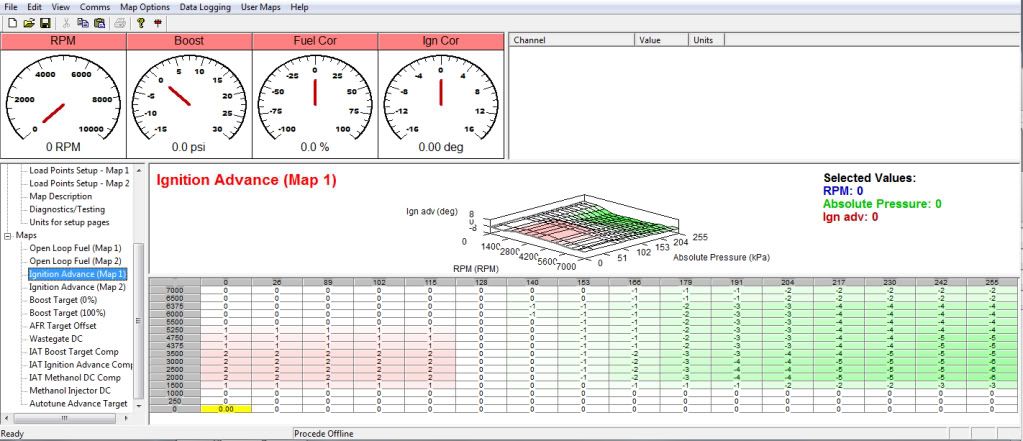 This table establishes the amount of corrective ignition advance/retard applied by the Procede. A negative number indicates ignition retard. A positive number indicates ignition advance. This table is for advanced users only as mis-adjustment can result in severe detonation and possible engine damage. As with the Fuel Map, it is important to keep transitions between cells reasonably smooth without any big step changes. For added safety, maximum advance is limited to +2 degrees. The Y-axis represents RPM. The X-axis is charge pipe pressure (pre-throttle body) in kiloPascals (kPA). 100kPa is equal to 1 bar (1 atmospheric pressure or 14.5psi) at sea level (0psi). 200kPa is equal to 2 bar of pressure (1 bar, or 14.5psi of boost) The active cell is highlighted when the User Software is connected to the Procede. Changes to this table can be made "on the fly" with the engine running. No Procede resetting necessary. Ignition Advance Map 2 (Ignition Advance Correction table for Map2) Same as above but for Map 2. IAT Ignition Map 1 (IAT Ignition Compensation for both Map1 and Map2) 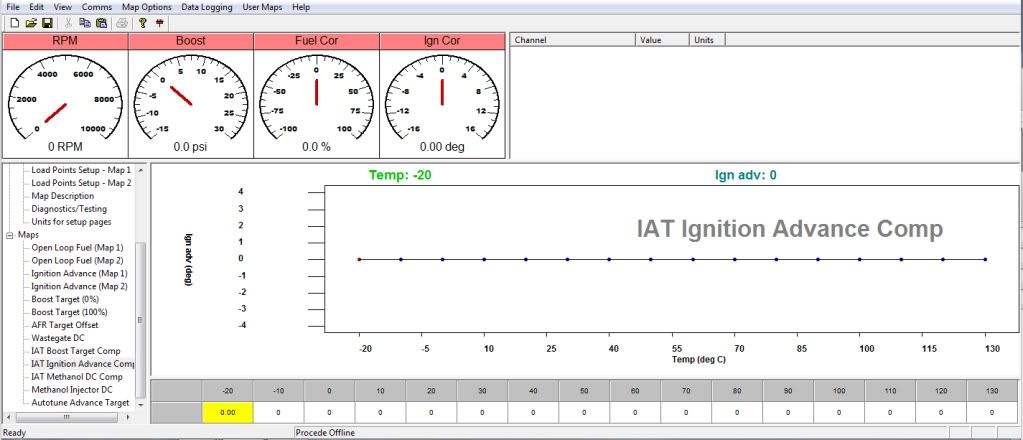 This map defines the effect Intake Air Temp (IAT) has on ignition correction. While it is useful to reduce timing during periods of high IAT, the factory DME already does this. So it is typically unnecessary to implement this through the Procede. Please note that this this map influences boost Map1 and Map2. IAT Ignition Map 2 does something else altogether and should not be adjusted by the user. BOOST CONTROL MAPPING Boost Target (0%)  This table dictates the boost curve when Boost level (Start Boost %) is set to 0%. The X axis is RPM. Boost Target (100%) 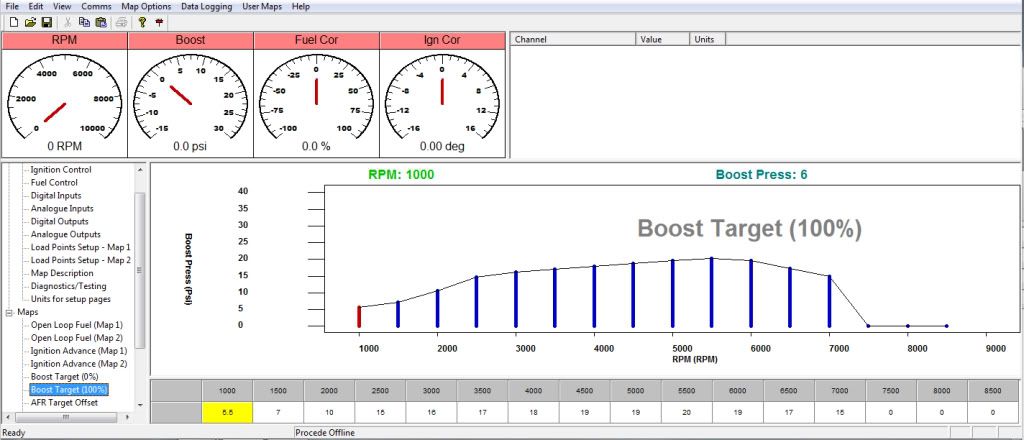 This table dictates the boost curve when Boost level (Start Boost %) is set to 100%. The X axis is RPM. Unlike the Map1/Map2 Fuel and Ignition maps, both Boost Maps work together at all times. Each map defines the max and min boost curve range. So you run a Start Boost % value of 0%, the Procede will target the boost curve defined in Boost Map 1. Likewise, if you run a Start Boost % value of 100%, the Procede will target the boost curve defined in Boost Map 2. And running a value of 50% will target a boost curve in the middle of both Boost Maps. It is VERY important to recognize this relationship before adjusting either map as a misunderstanding will result in an overboost! Changes to this table can be made "on the fly" with the engine running. No Procede resetting necessary. IAT Boost Target Comp (IAT Boost Correction for Map1)  This map defines the effect Intake Air Temp (IAT) has on the boost target. It is desirable to reduce the boost target when IAT climbs high (to avoid detonation) or drops exceptionally low (to avoid excessive engine load/fuel demand). A cell value of “0” indicates no correction. A cell value of “-100” indicates a -4psi reduction in boost target. In other words, for each -25 increment, boost target will be reduced by 1psi. The X axis is intake air temperature. Changes to this table can be made "on the fly" with the engine running. No Procede resetting necessary. Wastegate DC (Boost Control Duty Cycle Map for Map1 and Map2) 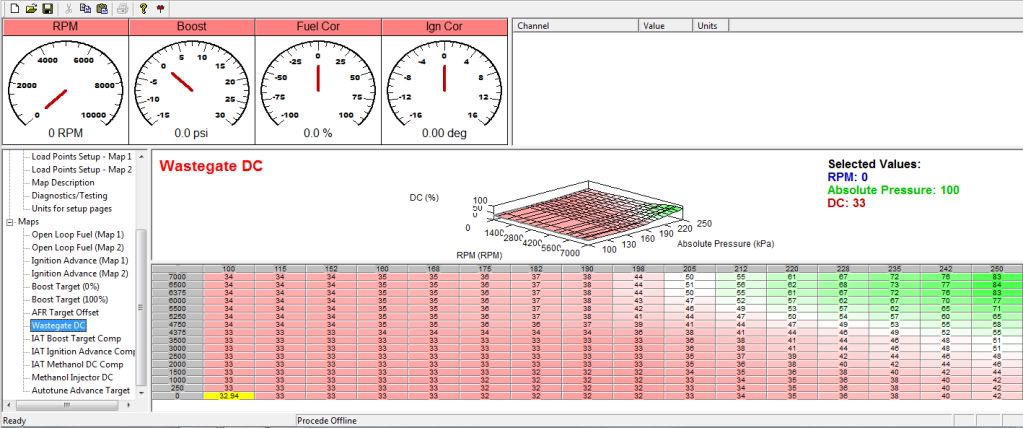 This table defines the amount of “base” boost control solenoid duty cycle (DC) % as a function of RPM and Boost Target (Boost Set Point). As with the Open Loop Fuel Map, an additional closed loop correction on top of this base value. You can monitor this correction by logging Boost Control Correction. If this correction is a negative value, the value in the Wastegate DC table is too high and the Procede’s closed loop boost control system is responding to an overboost condition and reducing wastegate DC% to compensate. If this correction is positive, the Procede’s closed loop boost control system is responding to an underboost and increasing wastegate DC% to compensate. The values in this table should be adjusted to achieve Boost Control Corrections close to 0%. Boost Control Correction has an authority range of +/- 12.5% DC. It’s also important to understand that the stock turbochargers will often not be able to achieve the boost control target at high RPM due to compressor limitations. So it’s normal to see very positive corrections at high RPM. These hardware limited corrections cannot be “tuned” out by adjusting the Wastegate DC table. Because of this, it is best to concentrate on the 3000-5500rpm range. This is NOT the case with upgraded turbos that do not share any such hardware limitations and can easily hit the boost target at higher engine speeds. In such applications, one will want to concentrate on the 3000-7000rpm range. The Boost Control Gain user adjustable is simply a multiplier to this table. There is no reason to adjust the Boost Control Gain user adjustable once you dial-in this table. Since the Boost Control logic is always running, the changes do not take effect immediately. Instead, you will need to Reset Procede (Comms->Reset Procede) after reach change. The Y-axis represents RPM. The X-axis is Boot Control Target/Set Point in kiloPascals (kPA). 100kPa is equal to 1 bar (1 atmospheric pressure or 14.5psi) at sea level (0psi). 200kPa is equal to 2 bar of pressure (1 bar, or 14.5psi of boost) The active cell is highlighted when the User Software is connected to the Procede. Boost Control PID Settings 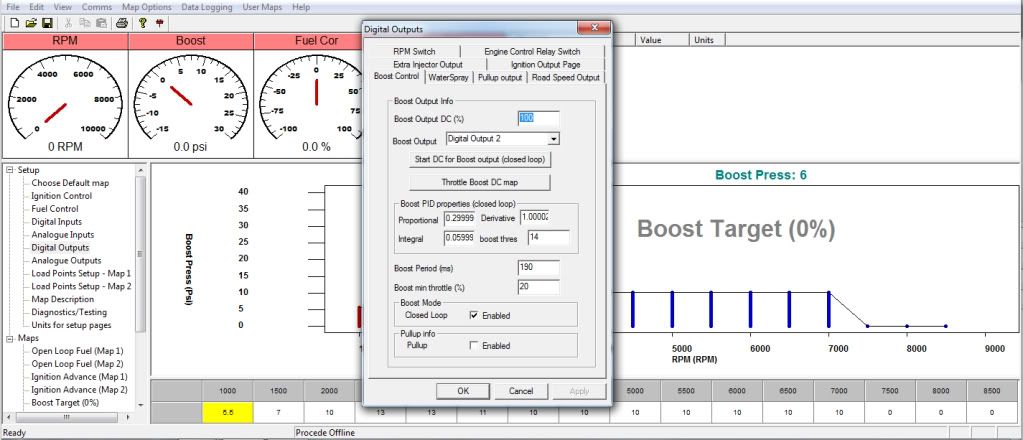 Set-up -> Digital Outputs -> Boost Control PID stands for Proportional, Integral and Derivative. They are the three error correction components in any PID system. They control how the computer responds to an error. In this case, the error is deviation from the boost target at any given time. These three settings will determine how quickly the Procede "zeros in" on the boost target. If any of of these values is improperly set, you will see many different kinds of boost controls anomalies (oscillation, slow response, overshoot, undershoot, etc,.) For more info on the these three components, read this: http://en.wikipedia.org/wiki/PID_controller In most cases, you will never need to adjust these settings. But changing them to best suit the mechanical characteristics of your engine can improve boost response and control accuracy greatly. Usually, you will only adjust the P (proportional) component by increasing until the point just before you start to see boost oscillation. If this value is too high, you will see erratic/bouncy boost control. If this value is set too low, you will see slow boost rise. The default values are conservative and err towards the "slow rise" side of the spectrum. When adjusting this value, it is best to do it in small 0.1 increments. Since the PID system is always running, the changes do not take effect immediately. Instead, you will need to Reset Procede (Comms->Reset Procede) after reach change. METHANOL INJECTION MAPPING Methanol Injector DC (Methanol Injection Duty Cycle Map) 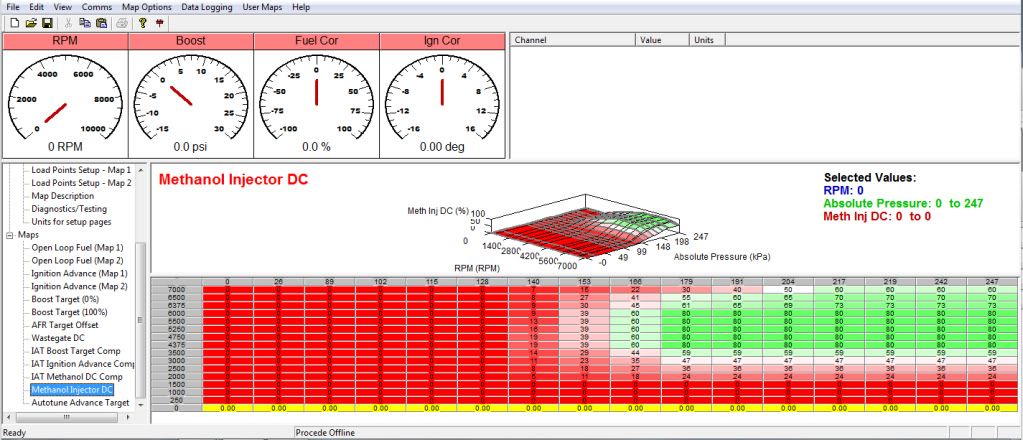 This table defines the duty cycle of the PWM methanol solenoid which operates at 25Hz. 0% results in the solenoid being completely closed. 100% results in it being completely open. 50% is half open and half closed (ie, open and closed in even intervales, 25 times a second). Due to mechanical inefficiencies, the min DC% required to open the solenoid is approximately 10%. Actual methanol flow (cc/min) will remain linear from that point onwards, up to approx 90% at which point the injector stay full open (static). This exceptional linearity gives the PWM meth system the very wide dynamic range that you will appreciate when it comes to fine tuning. The Y-axis represents RPM. The X-axis is charge pipe pressure (pre-throttle body) in kiloPascals (kPA). 100kPa is equal to 1 bar (1 atmospheric pressure or 14.5psi) at sea level (0psi). 200kPa is equal to 2 bar of pressure (1 bar, or 14.5psi of boost) The active cell is highlighted when the User Software is connected to the Procede. Changes to this table can be made "on the fly" with the engine running. No Procede resetting necessary. IAT Methanol DC Comp (Methanol Injection Duty Cycle Map)  This table adjusts the Methanol Injector DC output (as defined in th Methanol Injector DC map) with respect to Intake Air Temperature. This the adjustable range is -100 to +100%. With 0% being no change to the output. -100% basically disables methanol flow whereas +100% essentially doubles it (up to the 100% max duty cycle limit of course). With this table, you can make it so that the Procede increases methanol flow when more charge cooling is needed (extra hot conditions) and, conversely, decreases methanol flow when less charge cooling is needed (in extra cold conditions). Those who operate their engines in dynamic environments can benefit greatly from this feature. Last edited by OpenFlash; 07-04-2011 at 02:54 AM.. |
| 07-03-2011, 09:50 PM | #2 |
|
Major
 
60
Rep 1,065
Posts
Drives: RB PWRED E90 N54 6MT
Join Date: Aug 2006
Location: Bellevue, WA
|
wow!!!
__________________
RB Turbo/Procede V5/Vishnu PWM Meth Injection Kit/Vishnu DCI/AR Catless DP/AE Performance Exhaust(Sold)/Helix FMIC/Forge DVs/Rixster Vent Boost Gauge/Wavetrac LSD/KW V3/ACT Street Clutch Kit
|
|
Appreciate
0
|
| 07-03-2011, 09:56 PM | #3 |
|
Major
 
158
Rep 1,288
Posts
Drives: 2014 435iX, FBO
Join Date: Mar 2009
Location: Ontario, Canada
|
WOW, this is pretty amazing and intimidating all at the same time.
Is there anyway you can completely mess this up and blow your motor? Or does this dumb it down for us?
__________________
2020 M2 Competition HS, DCT, 763s, Carbon: splitter, side skirt, grill, diffuser, wing
Previous: 2014 BMW F32 435iX - JB4, MHD Flash, BMS Meth Kit, ER Intercooler, intake, catless DPs, KW Streets, 437M Reps with 245/35 and 275/30 Michelin PSS 4S |
|
Appreciate
0
|
| 07-03-2011, 09:58 PM | #4 |

1737
Rep 17,960
Posts
Drives: A Lot
Join Date: Sep 2006
Location: SF Bay, CA
iTrader: (0)
Garage List 2018 Ducati Panigal ... [0.00]
2016 Mazda CX5 [0.00] 2017 Aprilia Tuono ... [0.00] 2019 BMW M2 Competi ... [0.00] 2015 BMW M5 Competi ... [10.00] 2016 Ducati XDiavel S [0.00] 2016 AMG GT S [0.00] 2011 Ferrari 458 It ... [0.00] 2017 Charger Hellcat [0.00] 2015 KTM Super Duke ... [0.00] 2016 KTM RC390 [0.00] |
oops. half the tutorial got truncated (boost control and meth control). Just added it back so hit refresh
 |
|
Appreciate
0
|
| 07-03-2011, 10:00 PM | #5 |
|
Colonel
 131
Rep 2,408
Posts |
Wow that is awesome to have this kind of control for those who want it. Can't wait to see dynos seeing how much one can gain beyond the off the shelf map.
|
|
Appreciate
0
|
| 07-03-2011, 10:05 PM | #6 |

1737
Rep 17,960
Posts
Drives: A Lot
Join Date: Sep 2006
Location: SF Bay, CA
iTrader: (0)
Garage List 2018 Ducati Panigal ... [0.00]
2016 Mazda CX5 [0.00] 2017 Aprilia Tuono ... [0.00] 2019 BMW M2 Competi ... [0.00] 2015 BMW M5 Competi ... [10.00] 2016 Ducati XDiavel S [0.00] 2016 AMG GT S [0.00] 2011 Ferrari 458 It ... [0.00] 2017 Charger Hellcat [0.00] 2015 KTM Super Duke ... [0.00] 2016 KTM RC390 [0.00] |
We have applied reasonable upper and lower limits for boost, fuel and ignition mapping. This *should* keep someone from doing anything completely reckless. Certainly quite a bit safer than ROM editing. But nothing of this nature will be 100% foolproof. Care and understanding are prerequisites to anything worth doing. Custom tuning your engine is no different.
|
|
Appreciate
0
|
| 07-03-2011, 10:06 PM | #7 |
|
Major General
  
422
Rep 8,003
Posts
Drives: '08 E90 335i, '99 E36 M3
Join Date: Apr 2009
Location: Houston, TX & Atlanta, GA
|
Awesome!
|
|
Appreciate
0
|
| 07-03-2011, 10:20 PM | #8 |
|
Mad Linux Guru On The Loose
1121
Rep 5,396
Posts
Drives: 2008 335i Sedan, 2023 M3
Join Date: Aug 2009
Location: Chicago, IL
|
This looks very very interesting and I think this will definitely deserves high praises from the Procede community!
 I am bit confused though: This engine and the ECU targets load, not boost. So it will adjust the boost based on the environment variables (octane, temps, coolant temps, etc etc etc...) Yet here we have boost targeting? So what happens if a user creates a map which targets say X psi of boost, but the environment variables only allow X-2 psi of boost? Is that even possible to occur and if so, are there any built in safety systems?  
__________________
6MT | COBB | AR | AE | Forge DV | HPF | P3 Gauge | Hybrid Intake | O.S.Giken TCD | All M3 bits | TCKLine | StopTech | UUC | ER | SPEC
|
|
Appreciate
0
|
| 07-03-2011, 10:26 PM | #10 |
|
Lieutenant Colonel
 65
Rep 1,708
Posts |
Question: wastegate DC setpoint is in absolute kpa, but we log psi with 14.5 for baro. I'm at 1000ft. Logging absolute and maybe setting absolute boost using all the same units would make it much easier... I would thing??
|
|
Appreciate
0
|
| 07-03-2011, 11:08 PM | #14 |
|
Chump

10
Rep 173
Posts |
It's conceivable that you guys could create a datalog parser that could allow users to import multiple logs that cover many power/load ranges and spit out some "safe" assumption maps.
I guess, essentially, this seems like it opens a lot of doors for you guys to improve your auto-tuning abilities given the development time. Loved this post, it's exactly why so many of us are loyal Procede users! You are making all of the power users drool...  ++Power! |
|
Appreciate
0
|
| 07-04-2011, 12:06 AM | #15 | |
|
Reborn

87
Rep 1,217
Posts |
Great news!
Quote:
Yup, in fact I used a similar user-developed program to do just that on my old WRX. It saves a lot of time because you can view your logs as deltas to your targets (AFR, Boost, etc). |
|
|
Appreciate
0
|
| 07-04-2011, 01:00 AM | #17 |
|
Lieutenant
   
111
Rep 537
Posts |
well I know what I'll be learning how to do for the rest of the summer!
__________________
2018 X3 M40i - JB4 / BMS Billet Intake
2015 M4 6MT - JB4 / Gintani DPs 2005 M3 6MT - VF Engineering S/C / KW / StopTech / Dinan / HPF Stage III (removed)- Track Toy |
|
Appreciate
0
|
| 07-04-2011, 01:08 AM | #18 |
|
Major
 33
Rep 1,177
Posts |
Wow. This looks like a lot of work to pick up maybe another 5 or 10 WHP (if that).
I guess the bigger motivation would be improved drivability, but how would these custom settings change from summer to winter? |
|
Appreciate
0
|
| 07-04-2011, 01:49 AM | #19 |
|
Second Lieutenant
 21
Rep 203
Posts |
|
|
Appreciate
0
|
| 07-04-2011, 02:48 AM | #20 |

1737
Rep 17,960
Posts
Drives: A Lot
Join Date: Sep 2006
Location: SF Bay, CA
iTrader: (0)
Garage List 2018 Ducati Panigal ... [0.00]
2016 Mazda CX5 [0.00] 2017 Aprilia Tuono ... [0.00] 2019 BMW M2 Competi ... [0.00] 2015 BMW M5 Competi ... [10.00] 2016 Ducati XDiavel S [0.00] 2016 AMG GT S [0.00] 2011 Ferrari 458 It ... [0.00] 2017 Charger Hellcat [0.00] 2015 KTM Super Duke ... [0.00] 2016 KTM RC390 [0.00] |
You can easily pick up more than 5-10whp in certain parts of the power curve through custom mapping. Autotuning will be active soon so you can allow that to scale the tune up or down depending on conditions/climate.
|
|
Appreciate
0
|
| 07-04-2011, 03:06 AM | #21 |
|
Made in Italy

31
Rep 287
Posts
Drives: Former 135i
Join Date: Nov 2010
Location: ZH, Switzerland
|
Simply awesome.
  |
|
Appreciate
0
|
| 07-04-2011, 03:36 AM | #22 |
|
Brigadier General
 798
Rep 4,784
Posts |
Tuning a car to your specific needs is pretty much as good as it gets. Custom tuning FTW!!
__________________
ERnie
2016 BSM/f80/ZCP |
|
Appreciate
0
|
 |
| Bookmarks |
|
|